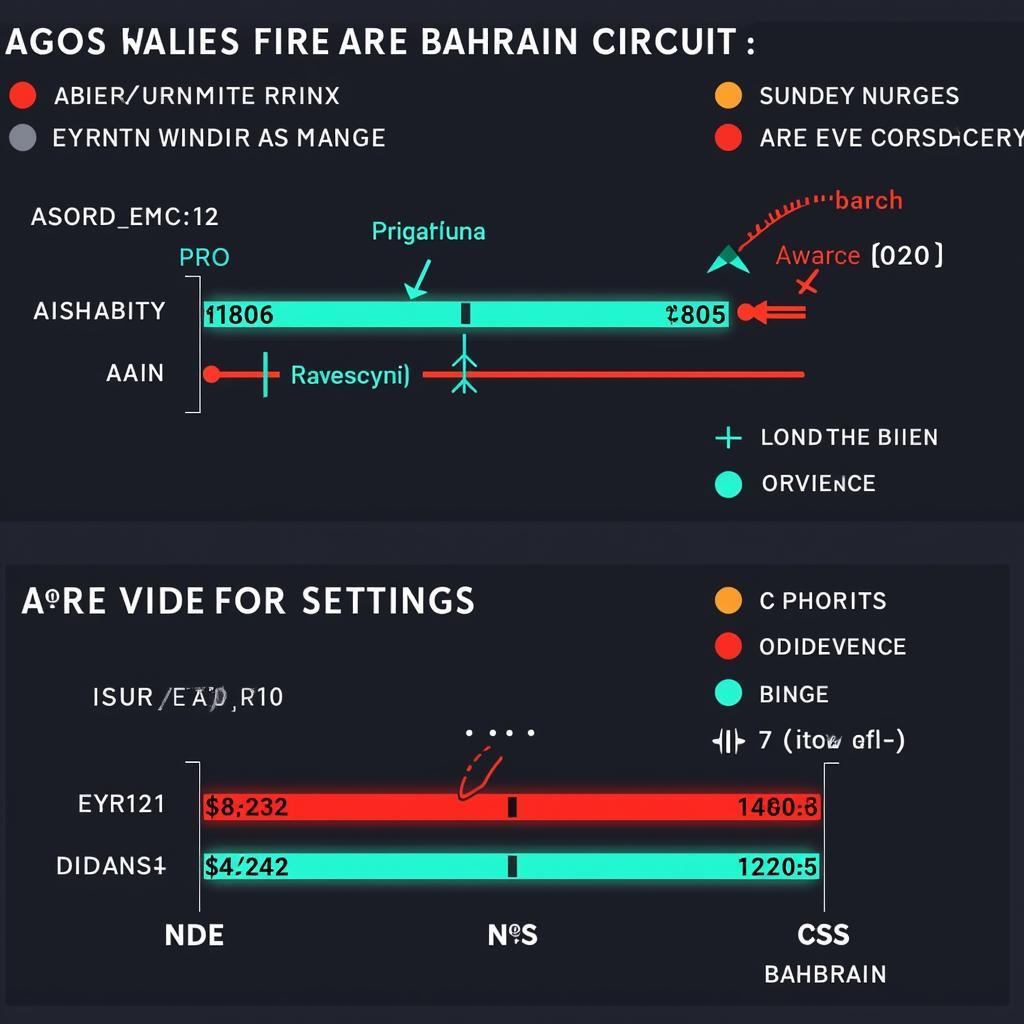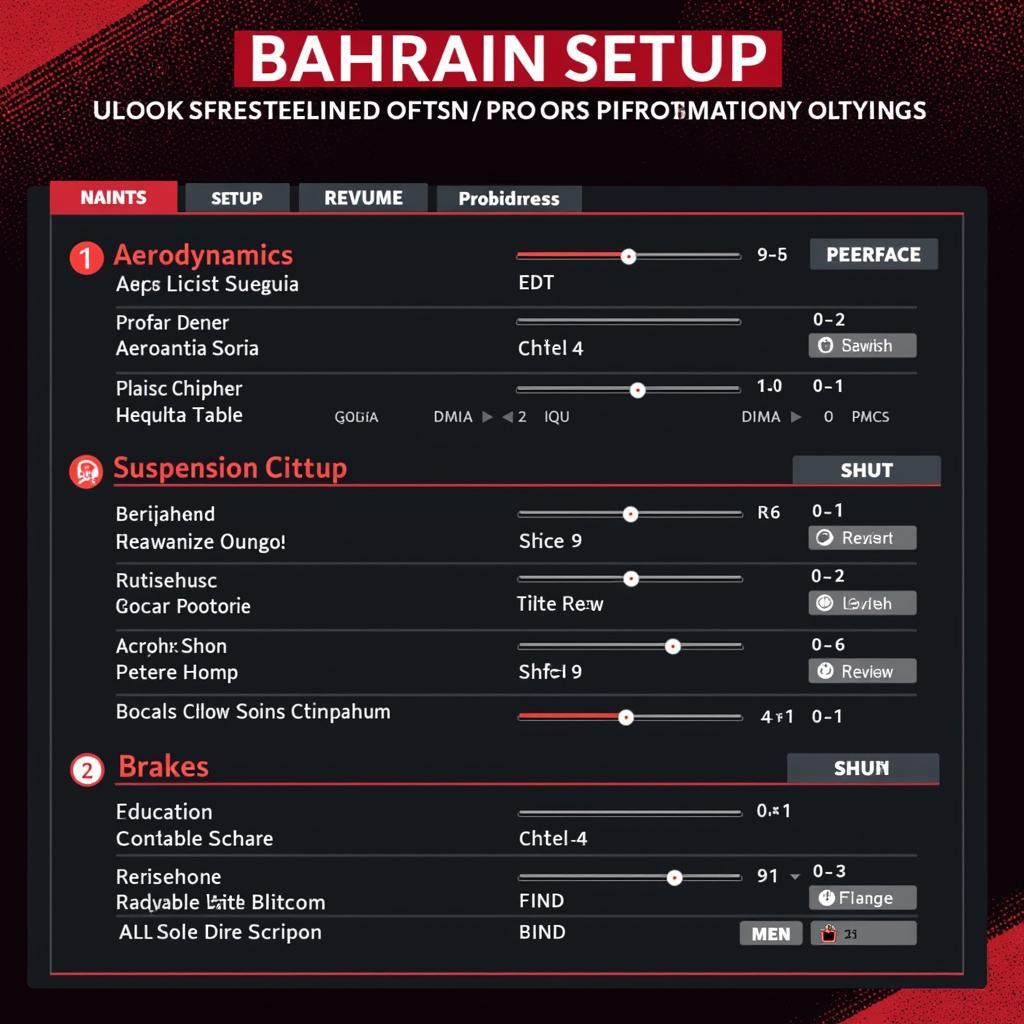Conquering the Bahrain International Circuit in F1 23 requires a finely tuned setup that balances speed, stability, and tire management. This guide will provide you with the knowledge and insights needed to optimize your Bahrain Setup F1 23, helping you navigate the challenging corners and long straights to achieve your best lap times. Whether you’re a seasoned veteran or new to the game, understanding the nuances of the Bahrain track and how to adapt your car’s setup is crucial for success.
Understanding the Bahrain International Circuit
The Bahrain International Circuit presents a unique challenge with its mix of high-speed sections, heavy braking zones, and technical corners. The track demands a setup that delivers good traction for the slower corners, while also maintaining stability and minimizing drag for the long straights. Tire degradation is also a significant factor, particularly in the later stages of the race. Understanding these key aspects of the circuit will inform your setup choices.
Aerodynamics: Finding the Right Balance
Aerodynamic balance is key to a successful Bahrain setup. You’ll want a lower downforce configuration to maximize straight-line speed, but enough to maintain stability through the high-speed corners like Turn 10. Experimenting with different front and rear wing settings is crucial to find the sweet spot between speed and grip. Too much downforce will compromise your top speed, while too little will make the car unstable and difficult to control.
 Bahrain F1 23 Aerodynamics Setup
Bahrain F1 23 Aerodynamics Setup
Suspension Setup: Balancing Grip and Responsiveness
The suspension setup plays a vital role in how your car handles the bumps and kerbs of the Bahrain track. A softer suspension setup can improve traction, but might make the car feel less responsive. Conversely, a stiffer setup enhances responsiveness, but can compromise grip, especially over the kerbs. Finding the right balance is essential for maintaining consistent lap times.
Brake Bias: Optimizing for Heavy Braking Zones
Bahrain features several heavy braking zones, particularly into Turn 1 and Turn 4. Optimizing your brake bias is crucial to ensure efficient braking performance and prevent lockups. A slightly forward brake bias can help with turn-in, but requires precise control to avoid locking the front tires. Experimenting with different brake bias settings during practice sessions will allow you to find the optimal balance for your driving style.
Tire Management: A Key to Success in Bahrain
Tire degradation is a major factor in Bahrain due to the abrasive track surface and high temperatures. Managing your tires effectively is essential for maintaining performance throughout the race. A smoother driving style, avoiding excessive wheelspin and lockups, can significantly extend tire life. Additionally, monitoring tire temperatures and pressures during the race is vital for making informed strategic decisions.
Bahrain Setup F1 23: Putting it All Together
A well-balanced Bahrain setup in F1 23 requires a holistic approach, considering the interplay between aerodynamics, suspension, brakes, and tire management. Don’t be afraid to experiment with different settings during practice sessions to find what works best for your driving style.
What are the key considerations for a Bahrain F1 23 setup?
Aerodynamics, suspension, brakes, and tire management are key.
How does tire degradation affect the Bahrain race?
Tire degradation is significant due to the abrasive track surface and high temperatures.
 Bahrain F1 23 Complete Setup
Bahrain F1 23 Complete Setup
Conclusion: Conquering Bahrain with the Right Setup
Mastering the Bahrain International Circuit in F1 23 requires a carefully crafted setup that balances speed, stability, and tire management. By following the principles outlined in this guide and experimenting with different settings, you can optimize your Bahrain setup F1 23 and unlock your full potential on this challenging track.
FAQ
-
What’s the ideal downforce level for Bahrain? A lower downforce configuration is generally preferred for Bahrain to maximize straight-line speed.
-
How important is brake bias for the Bahrain circuit? Brake bias is crucial due to the heavy braking zones, particularly into Turn 1 and Turn 4.
-
How can I manage tire degradation in Bahrain? Smooth driving, avoiding excessive wheelspin and lockups, can help extend tire life.
-
What are the key corners to focus on when setting up the car for Bahrain? Turns 1, 4, and 10 are particularly important.
-
Should I use a softer or stiffer suspension setup in Bahrain? Finding the right balance between softness and stiffness is essential. Experimentation is key.
-
What’s the impact of the long straights on the Bahrain setup? The long straights necessitate a setup that minimizes drag and maximizes top speed.
-
How can I find the best Bahrain setup for my driving style? Experimenting with different settings during practice sessions is the best way to find what works for you.
For further assistance, please contact us at Phone Number: 0902476650, Email: [email protected] or visit us at 139 Đ. Võ Văn Kiệt, Hoà Long, Bà Rịa, Bà Rịa – Vũng Tàu, Việt Nam. We have a 24/7 customer support team.





